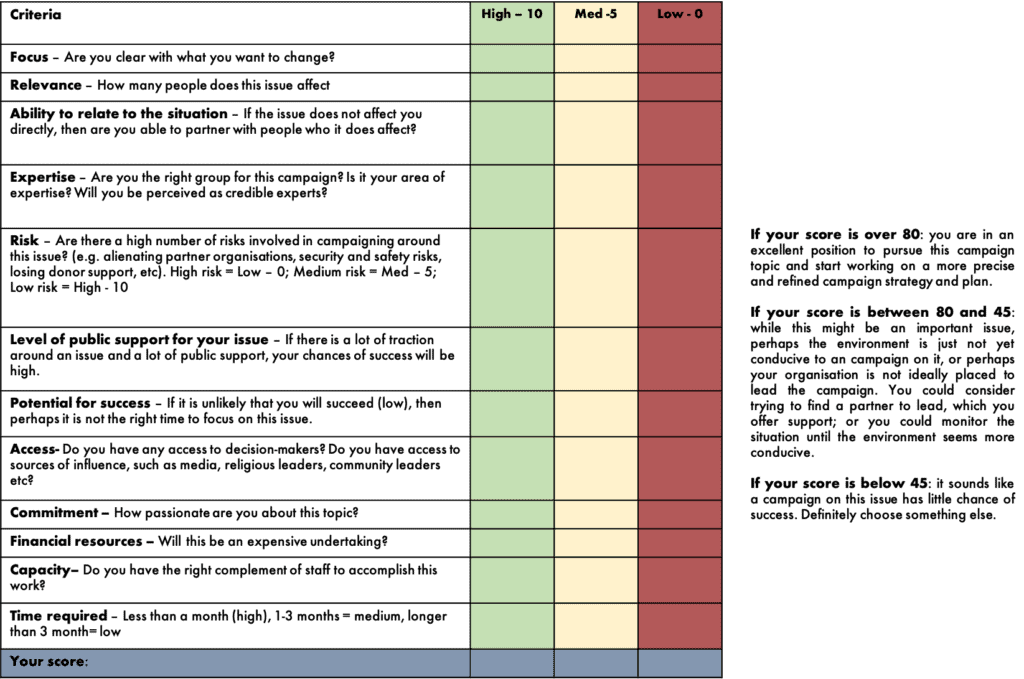Discover: Target Audiences & Problem Identification Copy
Discover: Understand the problem your audience faces. The aim of this step is to paint a clear picture of who your end users are, what challenges they face, and what needs and expectations must be met. Based on that, you can define a clear human-centred problem statement, focused on your users' needs.
Who are you talking to? It may seem like a simple question, but it is one of the questions many communicators struggle to answer. Campaigners and NGOs will often say “everyone” or spin out a very broad target audience statement.
Knowing who your target audience is, is key to be able to successfully achieve your intended results. Gaining a deep understanding of young people is the first step to youth-centred design, which is the underlying principle that should guide the design of your interventions for young people.
Broad target audiences
Broad target audiences have been a staple of media and communications for decades. Broadcasters use these to segment their shows, publications and articles. Typically, a broad target audience is based on demographic and geographic information. We can tell a great deal about a person simply by examining the demographic data about their life – their age, income level, education, occupation – but by itself, this data is only of limited use. It tells us nothing about their aspirations, their beliefs, their attitudes, or any other subjective psychological measure. Defining your broad target audience is the starting point. It is your first distillation of your audience.
Typically, a broad target audience is based on demographic and geographic information:
Demographic Information (I) | Demographic Information (II) | Geographic Information |
Age | Occupation | Resources |
Gender | Religion | Cultures |
Ethnicity | Nationality | Neighbourhoods |
Income | Lifecycle | City |
Qualification | Language | Region |
Marital Status | Race | Countries |
Sexuality | Media Use |
Engaging young people
Although it is widely accepted that youth should always be engaged in the design of programmes and interventions intended for them, there are various terms that are used interchangeably that refer to different ways or levels of youth engagement. The following table from Y-labs describes the differences between Youth-Led, Youth-Driven, and Youth-Centred design.
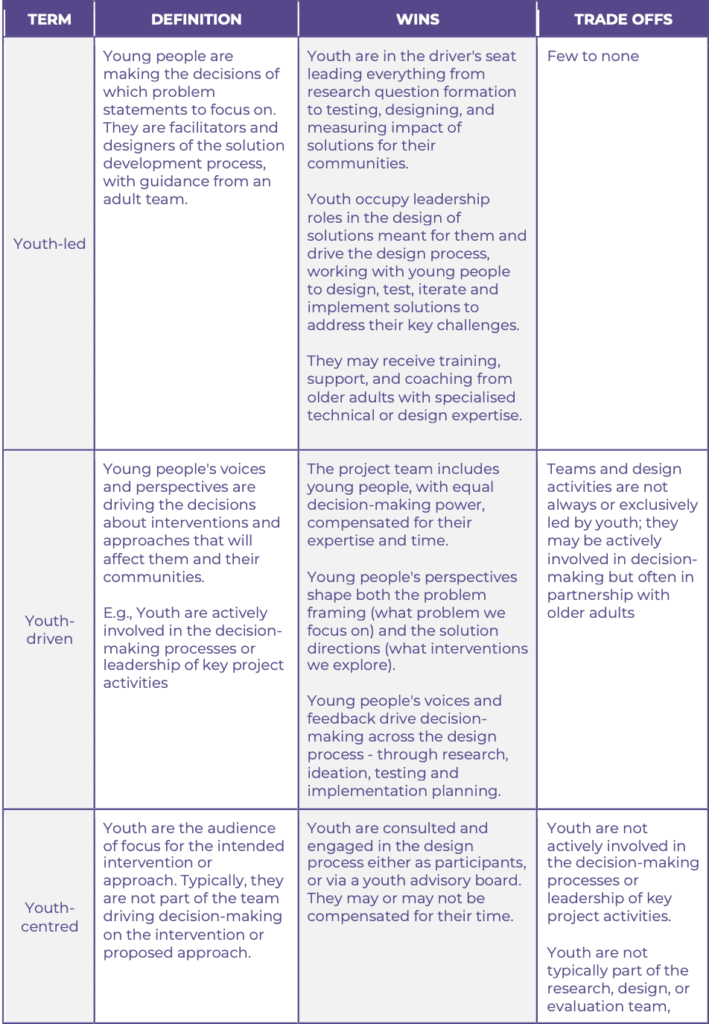
There are several resources that can help develop your meaningful youth engagement approach:
- The Youth-Centred Design Toolkit: a toolkit built around human-centred design tools and techniques in six chapters to guide you through the design process (UNICEF Canada’s One Youth movement)
- YLabs: is a global design and research organisation working to improve health and economic opportunity for young people between the ages of 10–24 years. Their website includes interesting publications on how youth centred design has been applied in projects worldwide
- UNICEF: Human-centered approach for Health: collection of resources on human-centred design approach with and for youth, including a detailed field guide
- HCD Exchange, a coalition centred around the goal of incorporating human-centred design (HCD) principles in adolescent sexual and reproductive health (ASRH) programs, which host seminars and events
- WHO Global Consensus Statement Meaningful Adolescent & Youth Engagement, including a helpful checklist for programming done in partnership with young people as well as links to other resources
The role of target audiences in channel selection
How can you determine on which channels you can find your target audience? Social listening tools can help you gain key insights into for example the gender, age and location of your social media audiences.
INDIVIDUAL LEVEL – DIGITAL CHANNELS
- What devices are end users using?
- What digital channels, apps and/or websites are most popular with young people?
- What are the technology and delivery channels being used for?
- What are young people’s digital habits?
- What levels of accessibility do young people have to technology?
- How affordable is internet/phone access for young people?
- What does phone ownership look like among young people? Is there phone sharing?
- What are the barriers and opportunities in digital engagement?
Source: WHO, “Youth-centred digital health interventions, A Framework for Planning, Developing and Implementing Youth-Targeted Digital Health Interventions”, 2020
Questions:
- Usage & Adoption: What channels are your target audiences using?
- Preferences: What are their preferred media and communication channels? and why?
- Barriers: Are there any barriers faced by your target group that can affect the choice of channel? Connectivity, costs, security?
In order to determine through which channel you can best reach your target audience, you need to research your channels, and find out key information about your channels including demographics and psychographics of the typical users. Different channels appeal to different types of audiences.
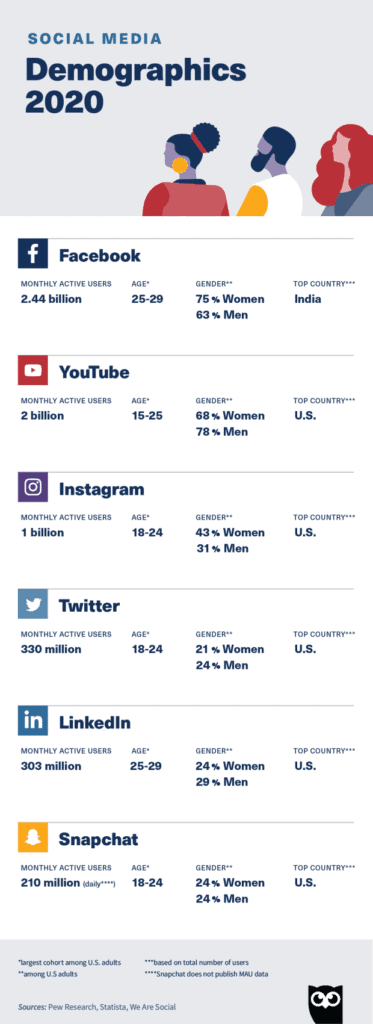
Questions:
- Demographics of your channel? What are the key demographics including age, gender, location?
- What are the average engagement rates (likes, comments, shares and clicks)? What is the average engagement rate of young people on the different channels?
Persona creation
Personas focus mostly on psychographic and behavioural information. A persona represents different characteristics of similar people (behaviour, motivation, goals and frustrations) into one fictional character through which a group can be understood. You can create multiple personas, to describe different target (sub)groups. However, start with developing 1-2 personas, and try to keep your personas to a maximum of 6. Too many personas will result in a lack of focus and not help you and your team to create targeted, persona-specific content. Choose your most important distinctive personas, to be targeted in your activities.
Why create a persona?
Making a fictional persona can help you to get in the mindset of your target audience. It forces you to step into their shoes and think about the things he or she encounters in his or her day-to-day life. It also helps to create a visualisation and common understanding of your target audience, which makes it easier to relate to.
Tip! The YCD Toolkit contains a complete set of resources to conduct a “build personas” workshop! It will help you build personas that are relevant to your organisation, service or program from real information and data.
How to create a persona?
Although a persona is a fictional character, they should be realistic and based on research, perhaps one of the young people you interviewed comes to mind? In order to create a persona, you want to provide a clear picture on what the persona thinks, sees, hears and does.
Ask the following questions:
- What does (s)he think? What really counts, preoccupations, worries and aspirations.
- What other opinions does (s)he hear? What do friends, bosses, influencers say?
- What does (s)he do? This includes attitudes, appearance, behaviour towards others, and behaviour online. How does (s)he act on his or her opinions? What hobbies, what kind of music does (s)he listen to, what is his or her favourite brand, and how would I recognise him or her on the street?
- What are the grievances, values, interests and needs that feed into this behaviour?
- Values: community, tradition, ideology;
- Grievances: poverty, lack of things, frustrations, obstacles, fears;
- Interests: sport, community, parties;
- Needs: Safety, income, friends, acknowledgment.
Research
A persona should be realistic. In order for a persona to be useful and easy to relate to, avoid creating stereotypical users and create a persona based on research data. You will therefore need to: get data, find patterns in the data & create personas based on those patterns.
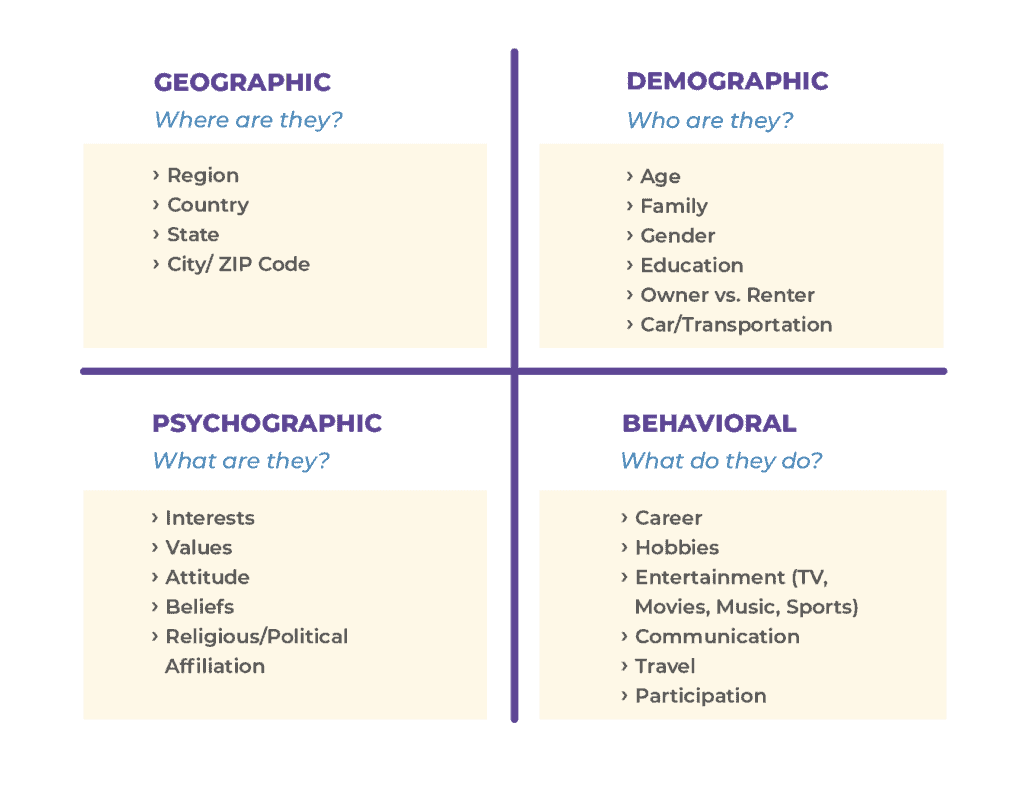
- Facts: Basic demographic information — age, gender, location.
- Relationships: Think about family, friends and professional connections.
- Activities: What do they do on a day-to-day basis? Include work, hobbies and habits.
- Digital behaviour: Their preferred social media channels, news and shopping websites.
- Wider world: What positive and negative trends in society affect and/or preoccupy them?
- Feelings: How do they feel at this point in time?
- Drives: What is pushing them towards your organisation?
- Goals: What are their goals? What is the problem they are experiencing and how can you help them solve it? What do they want to achieve through your organisation?
There are many tools available that can help you find the kind of information needed to be able to create a persona. You can use social media analytics, focus groups, baseline research, surveys, Google Trends, interviews, etc.
What problems are your users facing?
Be very clear about exactly what it is that you are trying to change – this step is an essential part of finding the right solution.Answer the questions:
- Why is it a problem?
- For whom is it a problem?
- What are the root causes of the problem?
- Why do you find this important?
You can use the 3 tools below to help you with problem discovery:
PROBLEM/SOLUTION TREE
AIM OF THE TOOL
- To help to understand complex challenges, and to find appropriate solutions by mapping out the cause and effect of each particular issue in detail.
HOW?
- Problem tree: causes form the roots of the tree, the core problem is the trunk, and the consequences are the branches of the tree.
- Solution tree: reverse the negative statements that form the problem tree into positive statements where the ‘challenge’ has been solved.
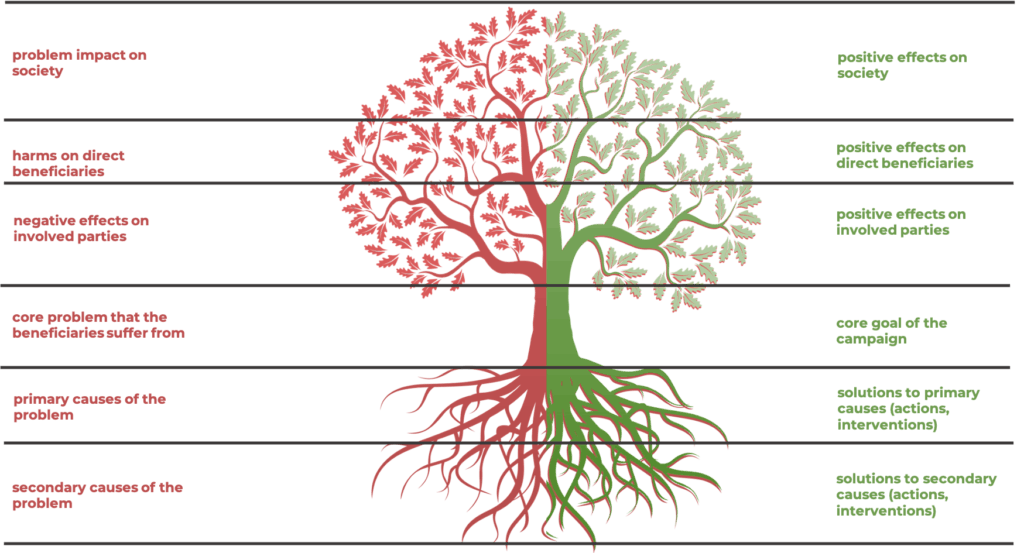
THE 4 QUADRANTS OF CHANGE
AIM OF THE TOOL
- To help consider what kind of changes need to happen, and which strategies are associated to them.
HOW?
- Complementary strategies are often needed to realise change. Fill in the quadrants using the solution tree statements to uncover all the changes that need to happen to solve the core issue. This doesn’t mean that you will work on all these changes.
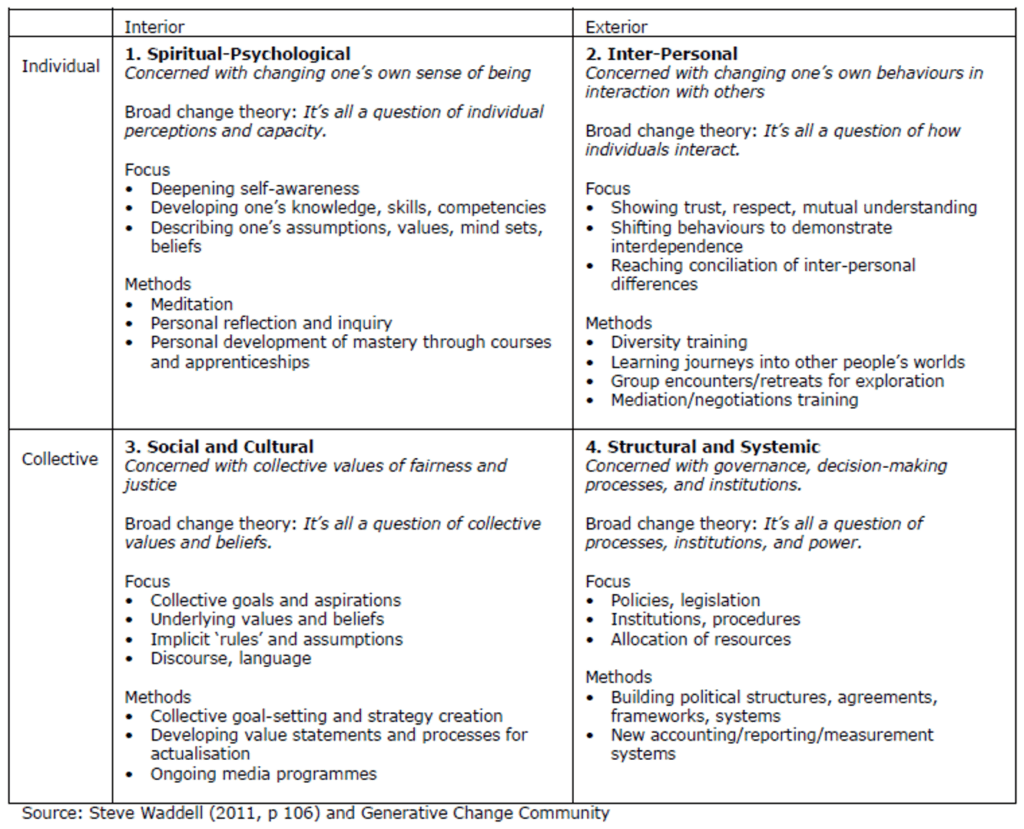
CRITERIA EVALUATION
AIM OF THE TOOL
- To make sure that the issue we face may be solved with resources that we would be able to mobilise.
HOW?
- Using the results of the problem/solution tree and the 4-quadrants of change, agree on 3 issues that the team feel most strongly about. You can use this list of criteria to help you explore these questions. Rate each criterion according to the scores for high, medium and low. Repeat the process with each campaign issue you’ve chosen to put on a shortlist and then compare the scores to more easily decide which issue seems to be best to focus on.
